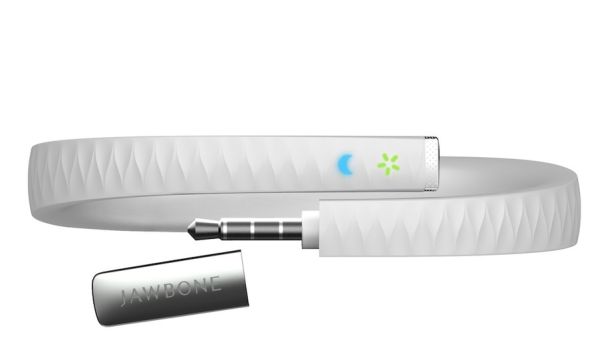UP Under the Hood
If you were to strip the rubber coating off the UP, you would find a strip of steel springs that keep the wristband’s shape. Mounted on the strip are the UP’s electronic components. These include a lithium-ion battery, a motion sensor and a vibration motor. On one end of the steel spring you’ll find the 3.5-millimeter jack. On the other end is a button that lets you change the UP’s mode of operation.
The battery provides the power and can last several days. Recharging requires you to plug the UP into a USB cable with a headphone-jack adapter.
The motion sensor detects changes in acceleration. Acceleration has two components: speed and direction. If an objection in motion experiences a change in either speed or direction, it has a change in acceleration. Motion sensors detect these changes through tiny electromechanical elements.
A basic solid-state accelerometer looks like a sandwich. The outer layers are capacitance plates carrying an electric charge. In between the plates is a weight suspended between them. When the entire sensor is still, the weight rests between the two plates. But in motion, forces act on the weight, which will move toward one plate and away from another. As the weight draws closer to one plate, its capacitance increases. The other plate experiences a decrease in capacitance. The sensor registers this as movement.
As you move over time, the weight continues to shift, causing more changes in the capacitance of the plates in the sensor. The sensor analyzes the data and converts it into information useful to you, including how many steps you’ve taken and an estimation of the number of calories you’ve burned.
What’s UP, iPhone?
The UP wristband doesn’t have a display. To get a look at all that precious fitness data, you’ll need to connect the UP to an iPhone, iPad or iPod touch — as of this writing, an Android app is in development. Plugging the TRS plug into your device’s headphone jack does the trick. But how can a headphone plug transmit data?
One of the most common uses of the 3.5-millimeter jack is for headphones. But that’s not the only type of data that can travel through a TRS plug. The TRS plug is made up of three conductors called the tip, ring and sleeve. When plugged into an appropriate jack, these three conductors make contact with three contact points. This allows for the transfer of data in the form of analog signals.
Data can travel in either direction along a TRS plug. When you plug in your headphones, data from your device travels through the plug up the wire to the speakers in your headphones. The speakers convert the data from electricity into sound. With the Jawbone UP, data travels from the sensor to the TRS plug into your device. The app accepts the data and translates it into a form that’s easy to understand such as how many steps you’ve taken or calories you’ve burned.
The app also lets you pair your device’s abilities with the UP. For example, the iPhone has a GPS receiver inside it. When going for a jog outside, you can set your app to use the iPhone’s GPS receiver to track your position during an activity. When finished, you can pair your UP with the iPhone and the app combines data gathered by the motion sensor in the UP and the GPS receiver in the iPhone.
Through the app, you can elect to share your progress with others via the Jawbone UP site, or keep it all to yourself. The app can also set challenges for you to conquer throughout the day. The vibrating motor in the UP lets you set an alert — sit still too long and the UP will begin to vibrate, signaling that it’s time to get a move on.
In sleep mode, the UP registers more subtle movements. In essence, it acts like an actimetry sensor. These sensors register a person’s movements as they rest and sleep. The UP system analyzes the data by processing it through proprietary algorithms. The result is a record of whether you slept like a log or tossed and turned all night long. Sleep and fitness are related — a good night’s sleep can help you reach fitness goals faster.
For more detail: How Jawbone UP Works

